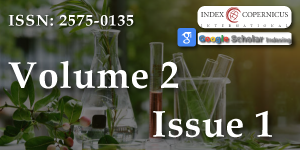Pharmacological effects of Nephrolepis exaltata L. (fern) aqueous extract on an insect-based model (Nauphoeta cinerea)
Main Article Content
Abstract
In this work we used semi-isolated heart of the cockroach Nauphoeta cinerea for the investigation of the pharmacological effects of extracts (aqueous, 1:1, 1:2, 1:4 and 1:8) from Nephrolepis exaltata L. leaves, a popular ornamental fern considered to be safe. The use of insects in experimental studies has grown due to the easy handling, proliferation/growing assuring its rapid obtention, and absence of ethical issues. An aqueous extract 0.2 % was obtained after maceration of 1 g N. exaltata leaves powder with 20 mL of distilled water (1:20). Diluted extracts in water were obtained to have the following proportion 1:1, 1:2, 1:4 and 1:8. Experiments (n=4) consisted of 200 µL addition onto semi-isolated heart preparation of N. cinerea with concomitant heart beating counting. Aqueous, 1:1 and 1:2 extracts paralyzed completely the heart beatings of cockroachs (p<0.05 compared to saline control), but not 1:4 or 1:8, which showed only a slight decline (p>0.05 compared to saline control). A preliminary thin layer chromatography showed the presence of unidentified terpenoid in aqueous extract of N. exaltata. These pharmacological findings of N. exaltata can be exploited for future use as insecticide or as dose-dependently cholinergic agent.
Article Details
Copyright (c) 2018 Sanchez DME, et al.

This work is licensed under a Creative Commons Attribution 4.0 International License.
Der Marderosian A, Giller F, Roia FJr. Phytochemical and toxicological screening of household plants potentially toxic to humans. Journal of Toxicology and Environmental Health. 1976; 1: 939-953. Ref.: https://goo.gl/uiHKdT
Geller-Bernstein CC, Keynan N, Bejerano A, Shomer-Ilan A, Waisel Y. Positive skin tests to fern spore extracts in atopic patients. Annals of Allergy. 1987; 58: 125-127. Ref.: https://goo.gl/BT2Stb
Stoof TJ, Bruynzeel DP. Contact allergy to Nephrolepis ferns. Contact Dermatitis. 1989; 20: 234-235. Ref.: https://goo.gl/kFmXZU
Andersen F, Paulsen E. Allergic contact dermatitis caused by the Boston fern Nephrolepis exaltata 'Bostoniensis'. Contact Dermatitis. 2016; 75: 255-256. Ref.: https://goo.gl/QoCEDy
Mironowicz A, Kromer K, Pawlowicz P, Siewinski A. Abilities of some higher plants to hydrolyze the acetates of phenols and aromatic-aliphatic alcohols. Acta Societatis Botanicorum Poloniae. 1994; 63: 43-48. Ref.: https://goo.gl/n9v7JS
Tu S, Ma L, Luongo T. Root exudates and arsenic accumulation in arsenic hyperaccumulating Pteris vittata and non-hyperaccumulatting Nephrolepis exaltata. Plant Soil. 2004; 258: 9-19. Ref.: https://goo.gl/CBajgA
Chen J, Shiyab S, Han FX, Monts DL, Waggoner CA, et al. Bioaccumulation and physiological effects of mercury in Pteris vittata and Nephrolepis exaltata. Ecotoxicology. 2009; 18: 110-121. Ref.: https://goo.gl/SD8WVc
Samarakkody R, Chathuranga D, Perera I, Fonseka DLCK, Iqbal MCM. Removal of cadmium (II) from contaminated soil by Nephrolepis exaltata. Conference: Interhational Symposium on Agriculture and Environment. 2014.
Rao RAK, Khan U. Adsorption studies of Cu (II) on Boston fern (Nephrolepis exaltata Schott cv. Bostoniensis) leaves. Applied Water Science. 2017; 7: 2051-2061. Ref.: https://goo.gl/7cuLXb
El-Tantawy ME, Shams MM, Affi MS. Chemical composition and biological evaluation of the volatile constituents from the aerial parts of Nephrolepis exaltata (L.) and Nephrolepis cordifolia (L.) C. Presl grown in Egypt. Natural Product Research. 2016; 30: 1197-1201. Ref.: https://goo.gl/7LUVmb
Edwards JS. The action and compostion of the saliva of an assassin bug Platymeris rhadamanthus Gaerst. (Hemiptera, Reduviidae). Journal of Experimental Biology. 1961; 38: 61-77. Ref.: https://goo.gl/kRhC8y
Rodrigues NR, Nunes ME, Silva DG, Zemolin AP, Meinerz DF, et al. Is the lobster cockroach Nauphoeta cinerea a valuable model for evaluating mercury induced oxidative stress? Chemosphere. 2013; 92: 1177-1182. Ref.: https://goo.gl/yYDtVQ
Nicolopoulou-Stamati P, Maipas S, Kotampasi C, Stamatis P, Hens L. Chemical Pesticides and Human Health: The Urgent Need for a New Concept in Agriculture. Front Public Health. 2016; 4: 148. Ref.: https://goo.gl/mnw2J9
Farmacopéia Brasileira. 4ª edição. São Paulo: Editora Atheneu. 1988.
Rodrigues V, Dörr FA, Morbi B, Pinto E, Dal Belo CA, et al. Effects of a cyanobacterial extract containing-anatoxin-a(s) um the cardiac rhythm of Leurolestes circunvagans. Brazilian Journal of Pharmacognosy. 2012; 22: 775-781. Ref.: https://goo.gl/R6a4iD
Barreto YC, Leal AP, Oliveira RS, Vinadé L, Santos TG, Dal Belo CA. Atividade neurotóxica do veneno de Rhinella ictérica (Spix, 1824) em baratas da espécie Nauphoeta cinerea. In: Anais do Salão Internacional de Ensino, Pesquisa e Extensão (SIEPE): 2016; Rio Grande do Sul. Rio Grande do Sul, RS: Universidade Federal do Pampa. 2016; 8. Ref.: https://goo.gl/GhjJR1
Harbone JB. Phytochemical Methods: A Guide to Modern Techniques of Plants Analysis. Chapman & Hall, London, England, 3rd Edition. 1998.
Simões CMO, Schenkel EP, Gosmann G, Mello JCP, Mentz LA and Petrovick PR. Farmacognosia: da Planta ao Medicamento. UFRGS/UFSC, Porto Alegre/Florianópolis, Brazil, 5th Edition. 2004.
Costa, KN, Gomes RM, Farrapo NM, Franco YO. Validação Farmacológica de Fitoqúimicos Comerciais sob o Parâmetro da Junção Neuromuscular (JNM) e do Perfil Cromatográfico. In: Oliveira JM, Gerenutti M, Miranda RC, Franco YO, Franzoni V. Os Múltiplos Olhares da Pesquisa: da observação ao conhecimento (pp. 13-29). Sorocaba: Eduniso 2011.
MeSH, Adrenaline. https://www.ncbi.nlm.nih.gov/mesh/?term=adrenaline Accessed 15/03/2018.
MeSH, Acetylcholine. https://www.ncbi.nlm.nih.gov/mesh/?term=acetylcholine. Accessed 15/03/2018.
Fryer AD, Maclagan J. Ipratropium bromide potentiates bronchoconstriction induced by vagal nerve stimulation in the guinea-pig. European Journal of Pharmacolgy. 1987; 139: 187-191. Ref.: https://goo.gl/3mE39W
Hennequin S, Hovenkamp P, Christenhusz M, Schneider H. Phylogenetics and biogeography of Nephrolepis -a tale of old settlers and young tramps. Botanical Journal of the Linnean Society. 2010; 164: 113-127. Ref.: https://goo.gl/6wkaDb
Kennedy DO, Wightman EL. Herbal extracts and phytochemicals: plant secondary metabolites and the enhancement of human brain function. Advances in Nutrition. 2011; 2: 32-50. Ref.: https://goo.gl/LypRwq
Rattan RS. Mechanism of action of insecticidal secondary metabolites of plant origin. Crop Protection. 2010; 29: 913-920. Ref.: https://goo.gl/hwC6ez

